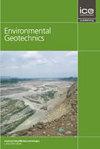Geotechnical property development and micro characteristic evolution of solidified sludge using a novel mixed agent
IF 2.2
4区 工程技术
Q3 ENGINEERING, GEOLOGICAL
引用次数: 0
Abstract
Low-strength sludge takes up a lot of space in landfills, creating an environmental concern and a resource waste that needs to be treated right away. A novel mixed solidifying agent in this work is introduced to the geotechnical characteristics’ improvement of sludge for the first time. The role of each component in the mixed agent is explored by a series of different additive dosages in solidification. According to water content tests, shear wave velocity tests, unconfined compression strength tests, direct shear strength tests, X-ray diffraction, and scanning electron microscopy, the strength development of solidified sludge is comprehensively analyzed under different dosages and curing ages. The micro-analysis result shows that the geotechnical characteristics improved mostly due to hydration products such as ettringite, calcium silicate hydrate gel, aluminum gel, and hydrogarnet. Besides, the generation of hydration products consumes the water in sludge, fills soil particle pores, and connects the soil particles, which makes the structure of solidified sludge compacted, hence, improving the strength of the solidified sludge. Furthermore, the relationship between the shear wave velocity and undrained shear strength parameters follows the power function and indicates that the shear wave velocity can characterize the strength level of the solidified sludge.新型混合剂固化污泥的岩土力学性能发展及微观特性演变
低强度污泥在垃圾填埋场占据了大量空间,造成了环境问题和需要立即处理的资源浪费。本文首次将一种新型混合固化剂引入到污泥的土工特性改善中。通过一系列不同添加剂用量的凝固试验,探讨了混合剂中各组分的作用。通过含水率试验、剪切波速试验、无侧限抗压强度试验、直剪强度试验、x射线衍射、扫描电镜等,综合分析了不同投加量和固化龄期下固化污泥的强度发展情况。微观分析结果表明,钙矾石、水合硅酸钙凝胶、铝凝胶、水榴石等水化产物对土工性能的改善作用最为显著。水化产物的产生消耗了污泥中的水分,填充了土壤颗粒孔隙,连接了土壤颗粒,使固化污泥的结构变得密实,从而提高了固化污泥的强度。剪切波速与不排水剪切强度参数之间的关系服从幂函数,表明剪切波速可以表征固化污泥的强度水平。
本文章由计算机程序翻译,如有差异,请以英文原文为准。
求助全文
约1分钟内获得全文
求助全文
来源期刊

Environmental geotechnics
Environmental Science-Water Science and Technology
CiteScore
6.20
自引率
18.20%
发文量
53
期刊介绍:
In 21st century living, engineers and researchers need to deal with growing problems related to climate change, oil and water storage, handling, storage and disposal of toxic and hazardous wastes, remediation of contaminated sites, sustainable development and energy derived from the ground.
Environmental Geotechnics aims to disseminate knowledge and provides a fresh perspective regarding the basic concepts, theory, techniques and field applicability of innovative testing and analysis methodologies and engineering practices in geoenvironmental engineering.
The journal''s Editor in Chief is a Member of the Committee on Publication Ethics.
All relevant papers are carefully considered, vetted by a distinguished team of international experts and rapidly published. Full research papers, short communications and comprehensive review articles are published under the following broad subject categories:
geochemistry and geohydrology,
soil and rock physics, biological processes in soil, soil-atmosphere interaction,
electrical, electromagnetic and thermal characteristics of porous media,
waste management, utilization of wastes, multiphase science, landslide wasting,
soil and water conservation,
sensor development and applications,
the impact of climatic changes on geoenvironmental, geothermal/ground-source energy, carbon sequestration, oil and gas extraction techniques,
uncertainty, reliability and risk, monitoring and forensic geotechnics.
 求助内容:
求助内容: 应助结果提醒方式:
应助结果提醒方式:


